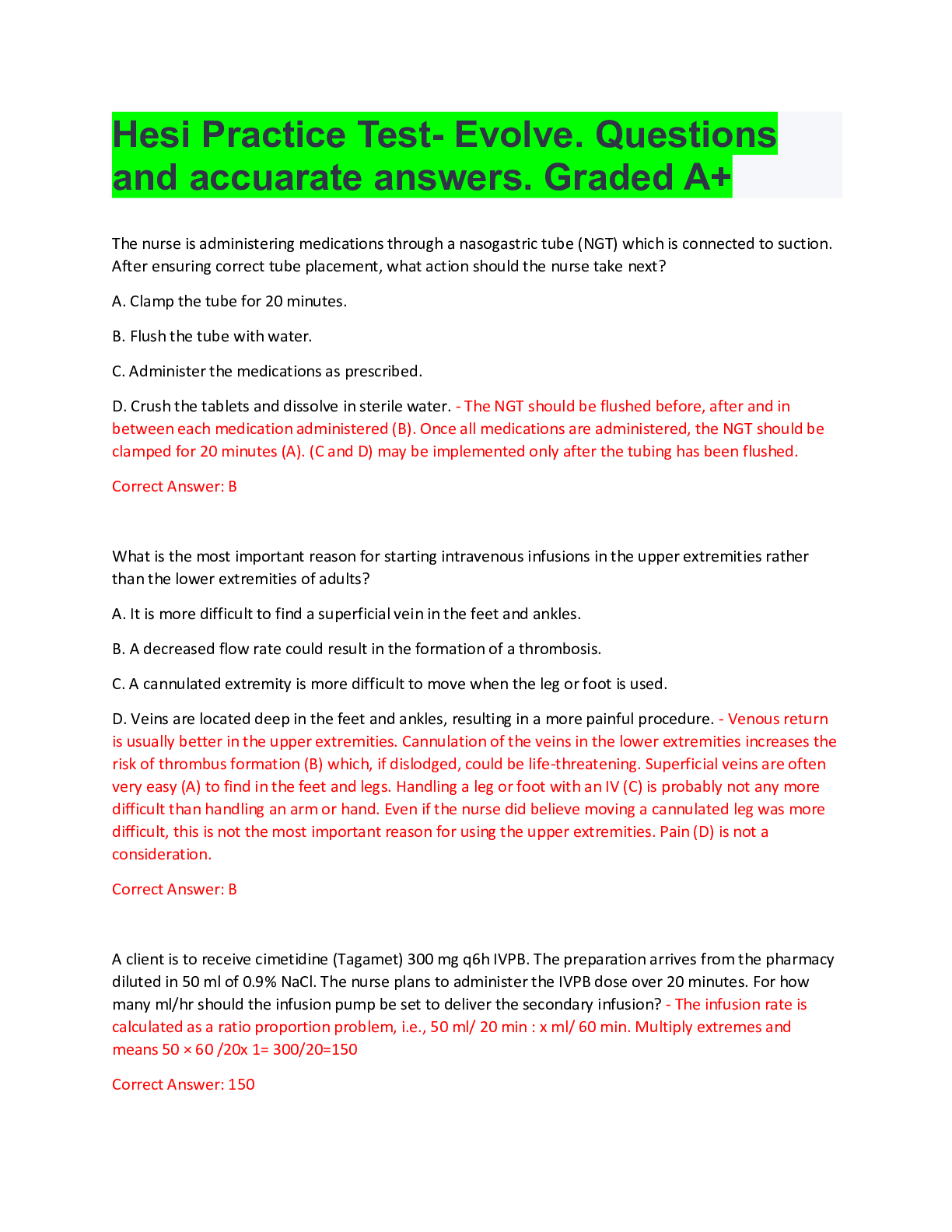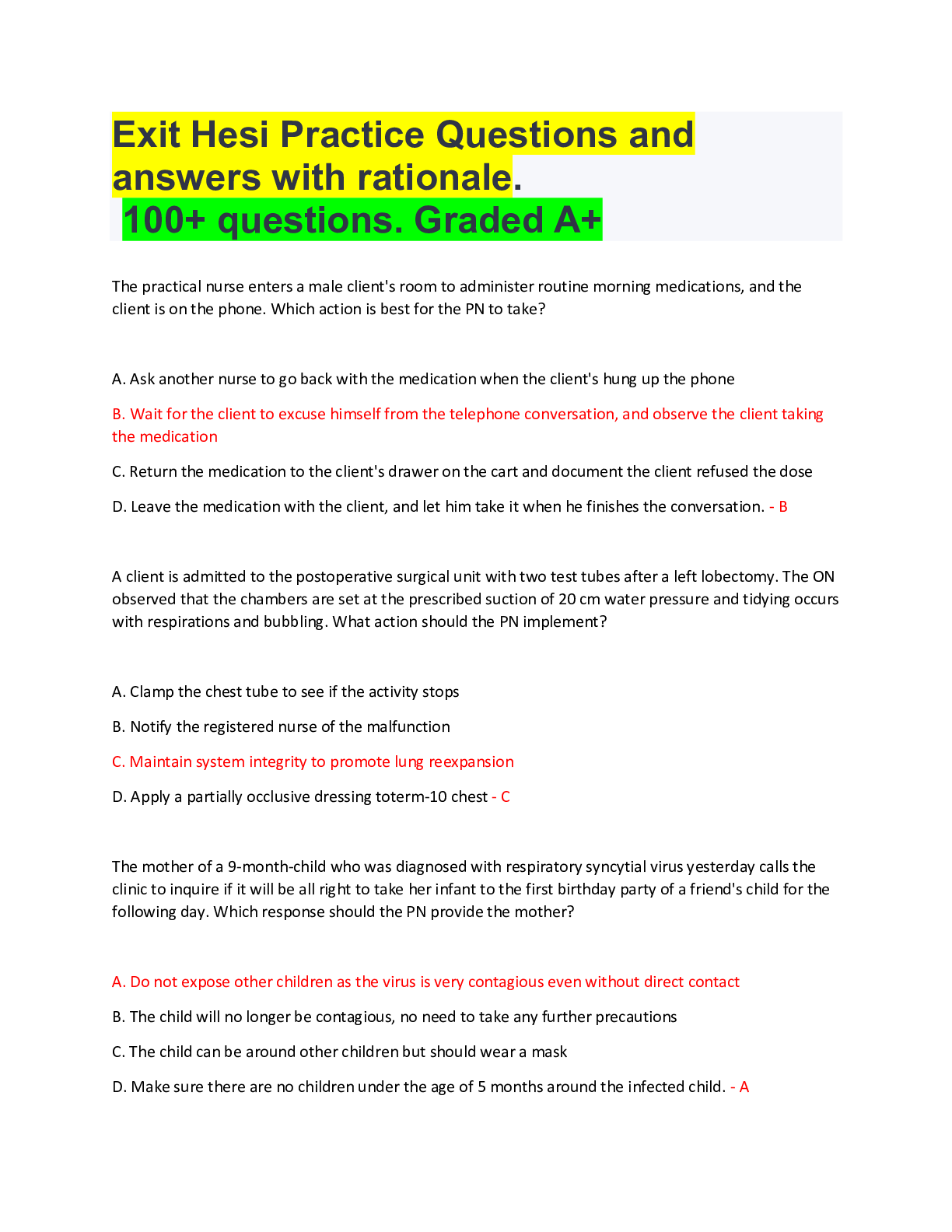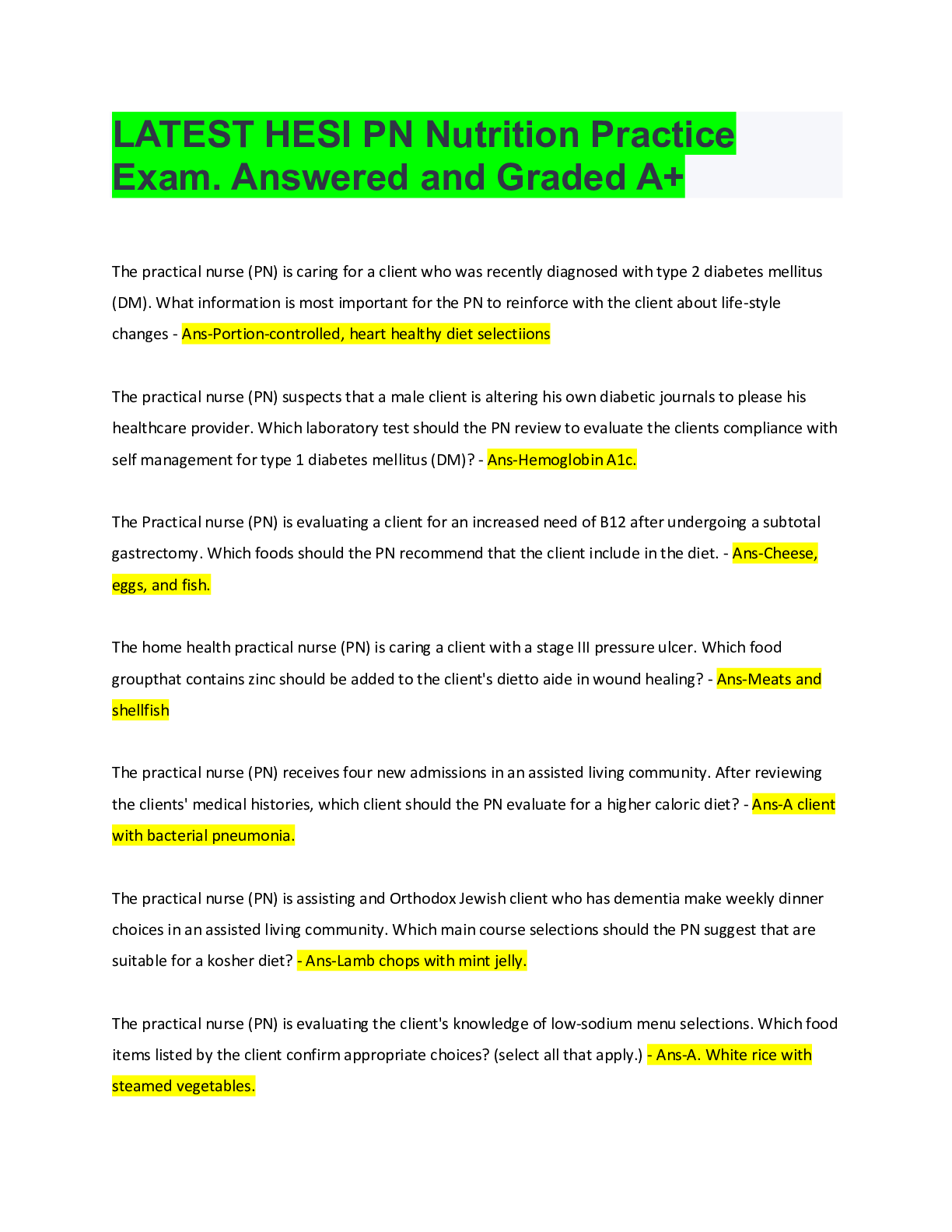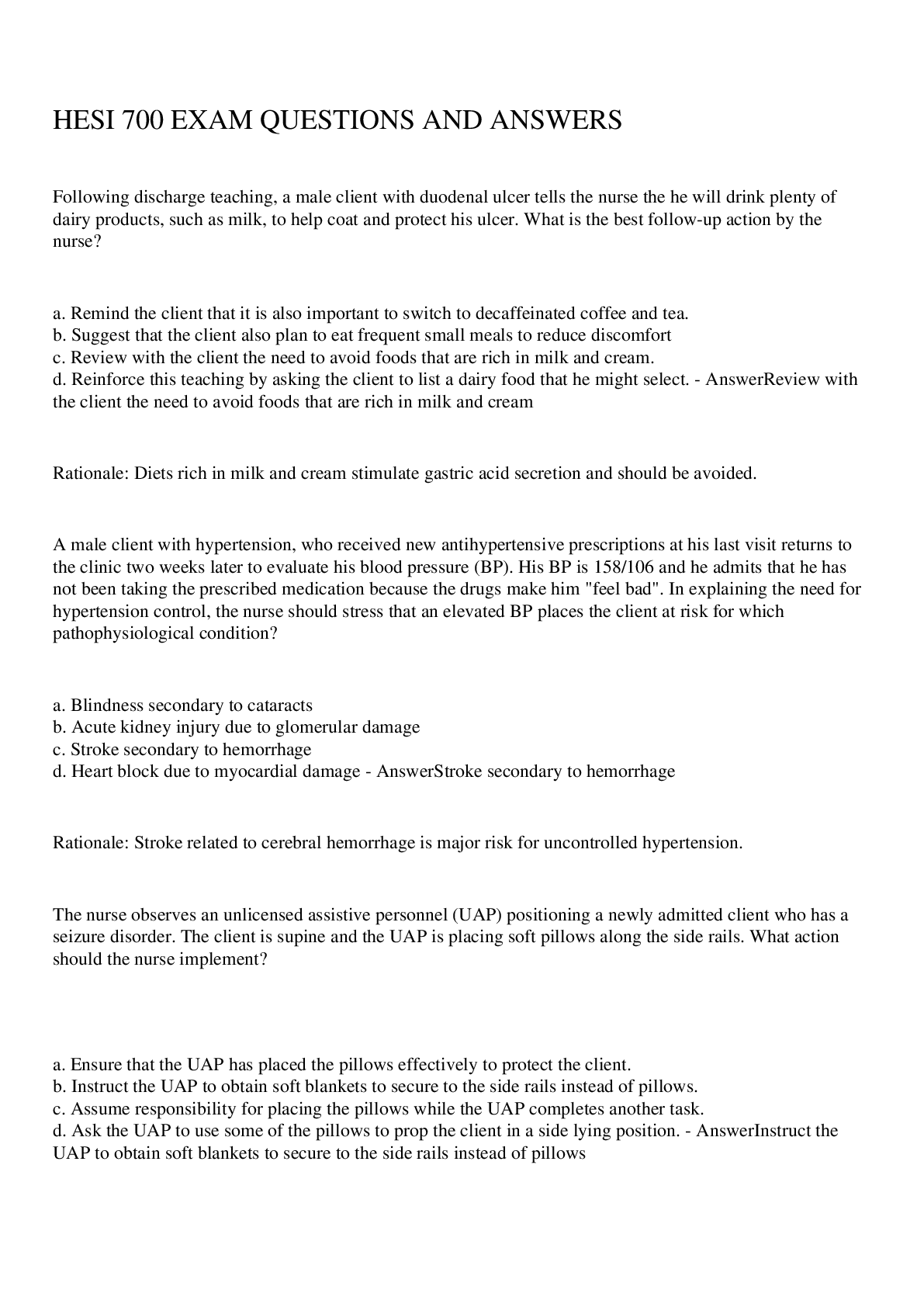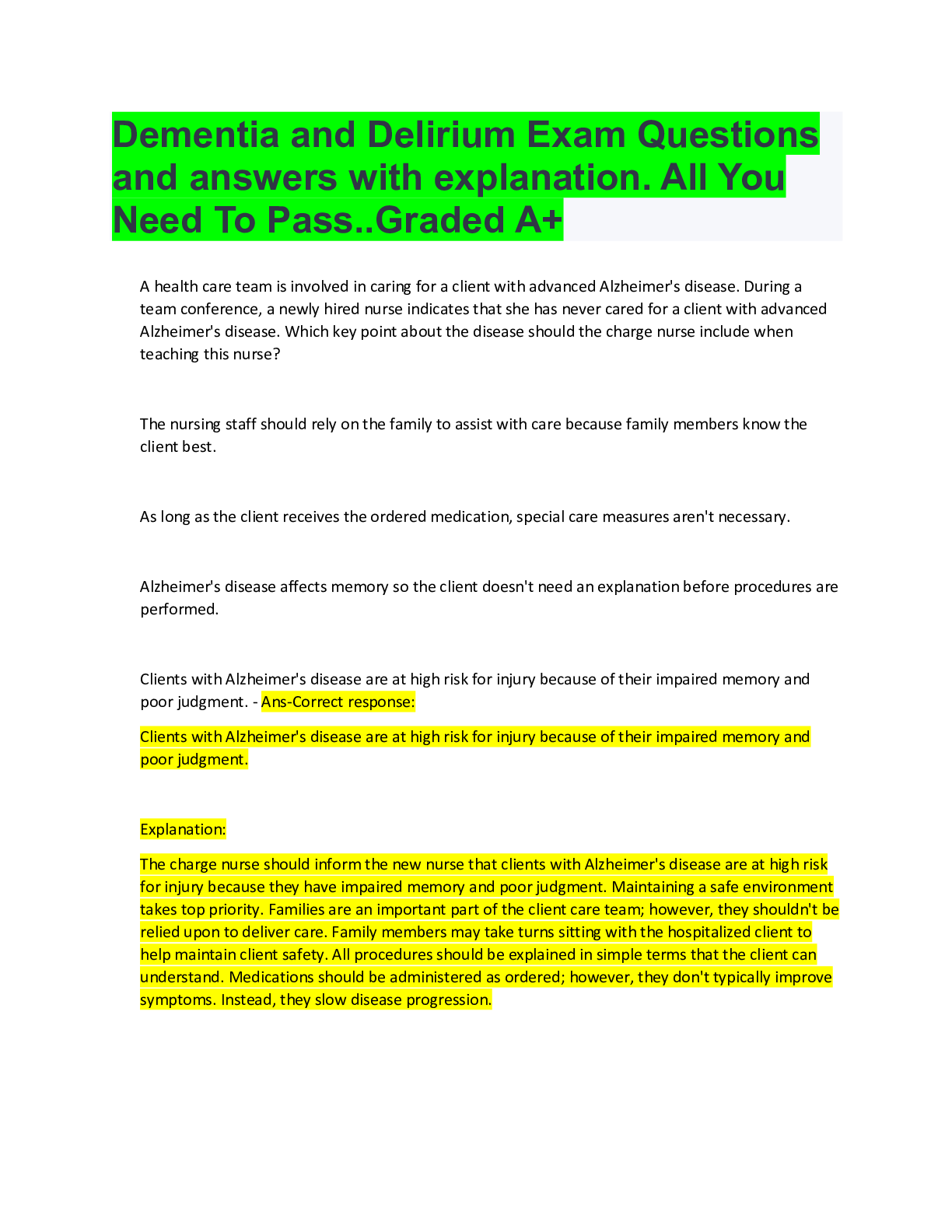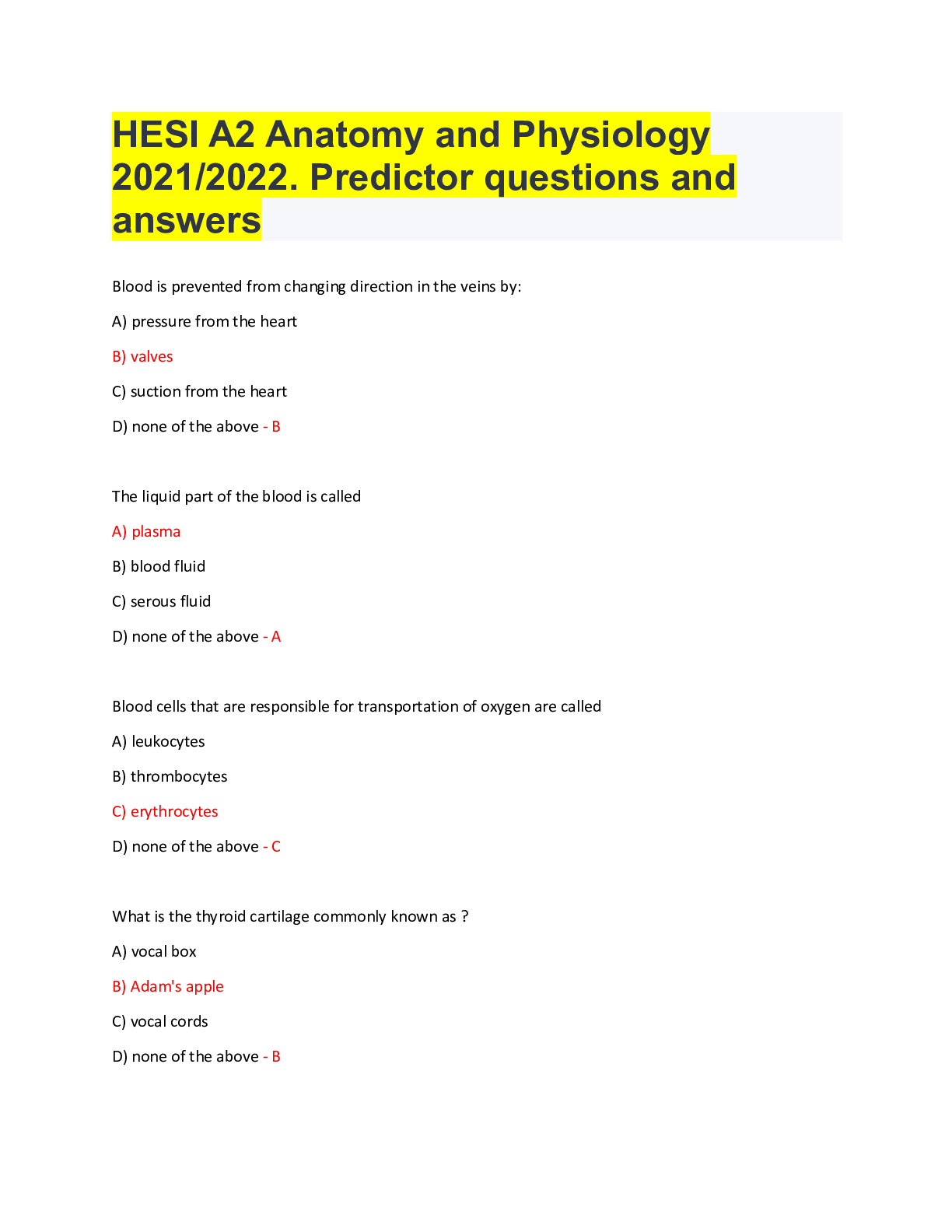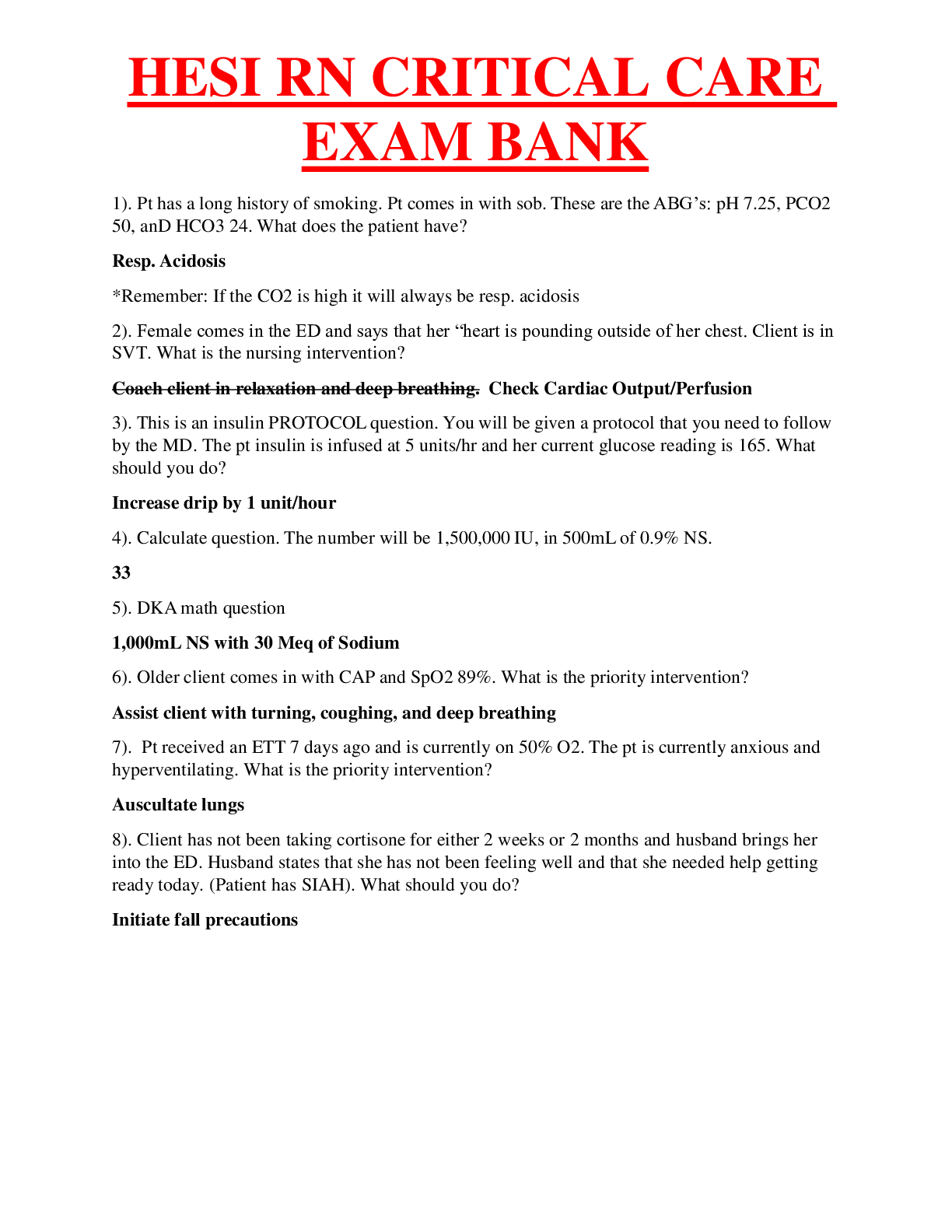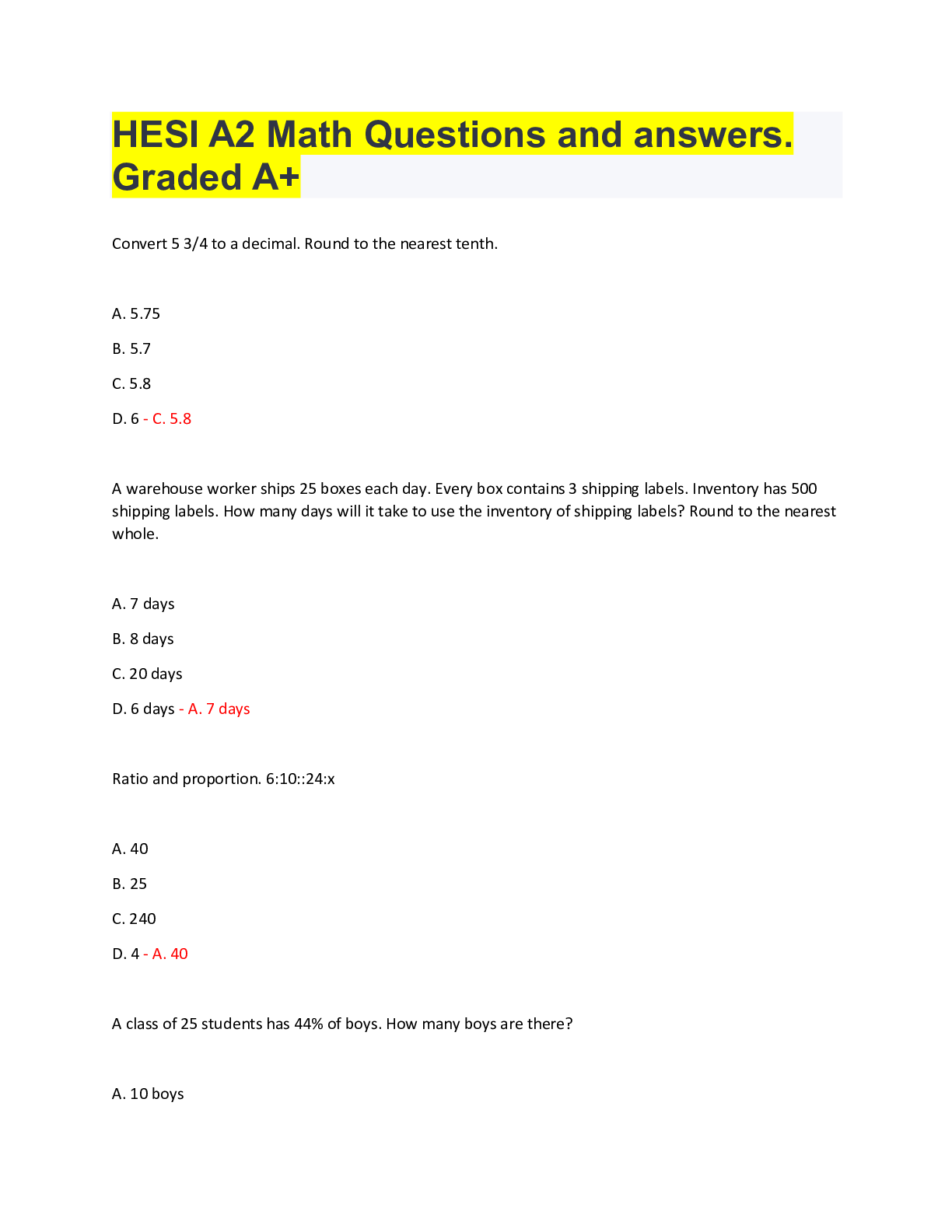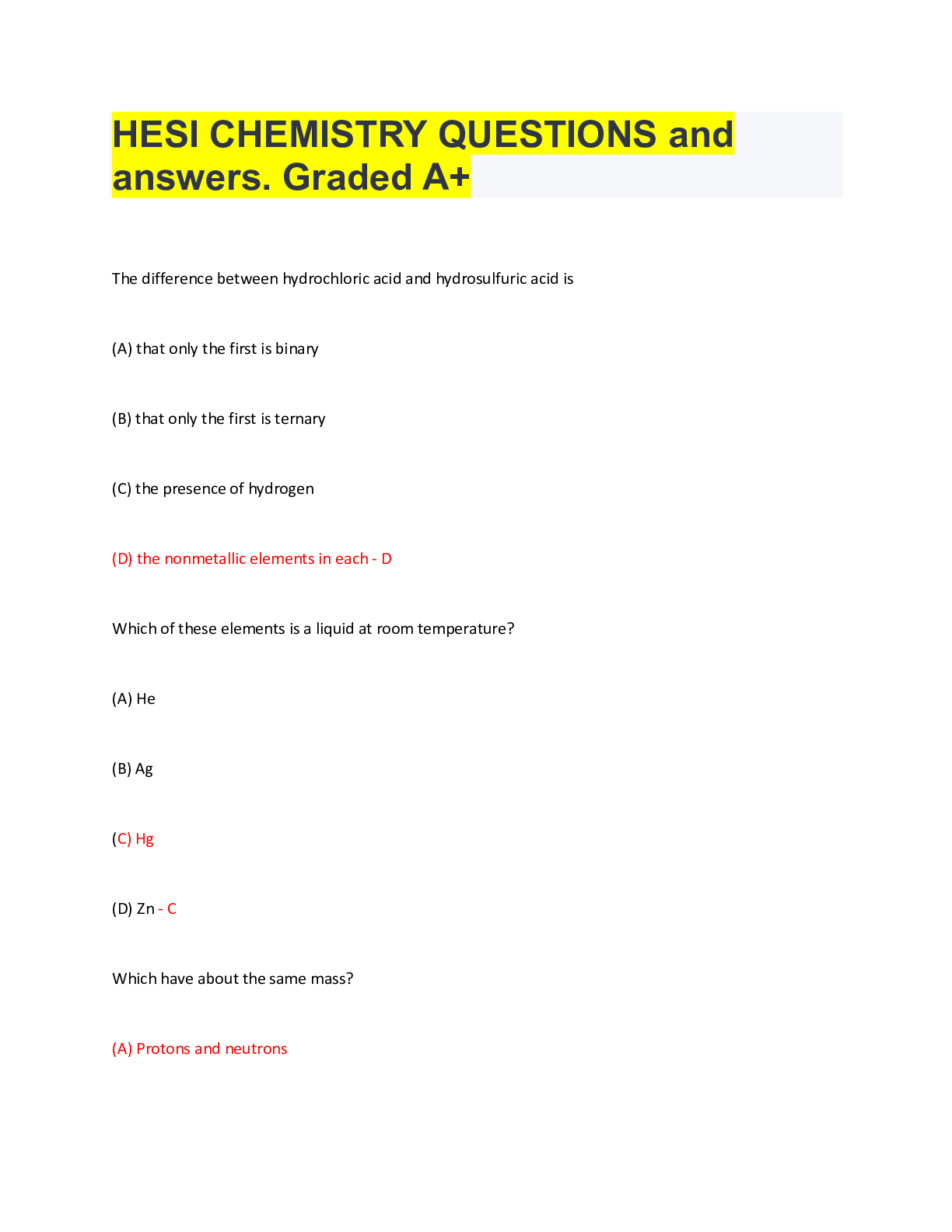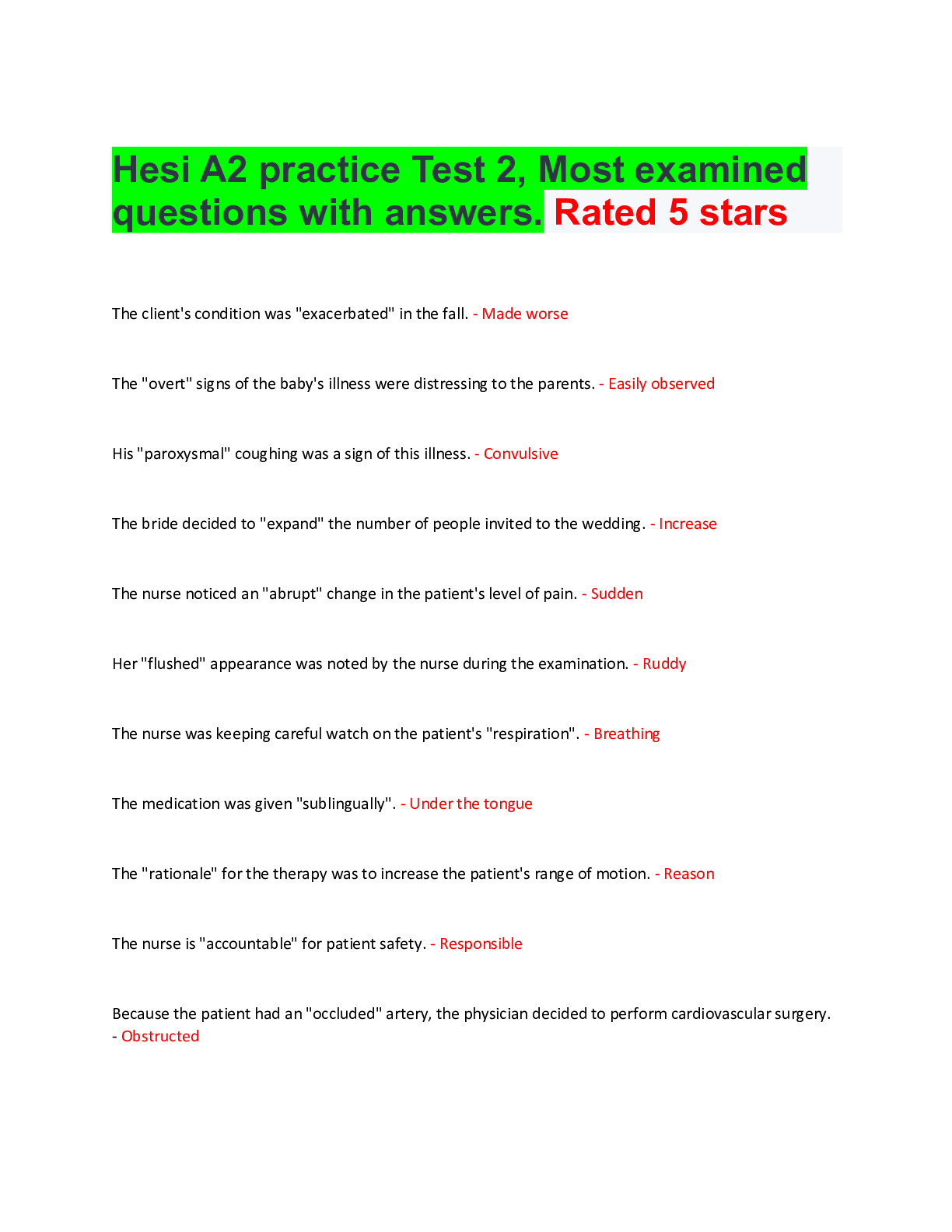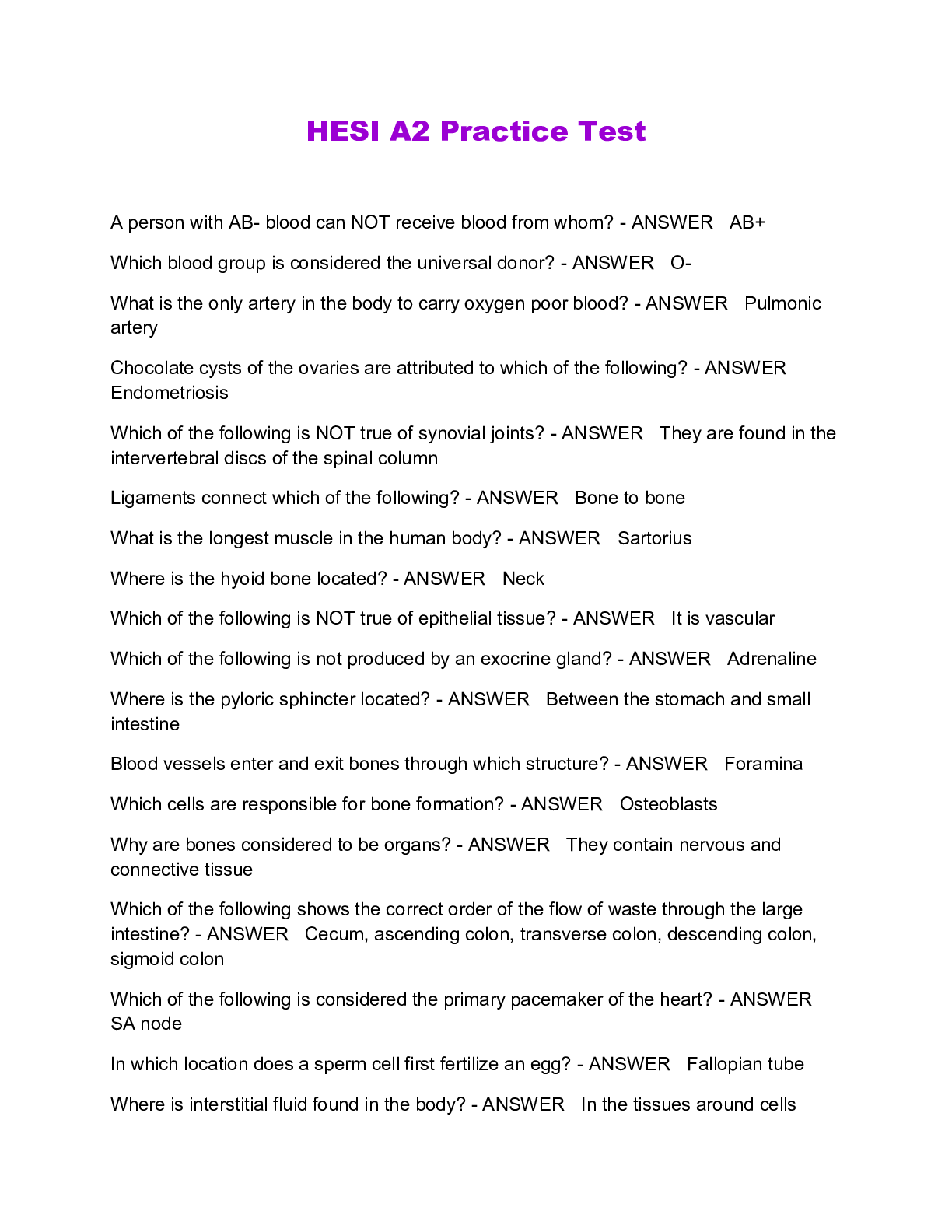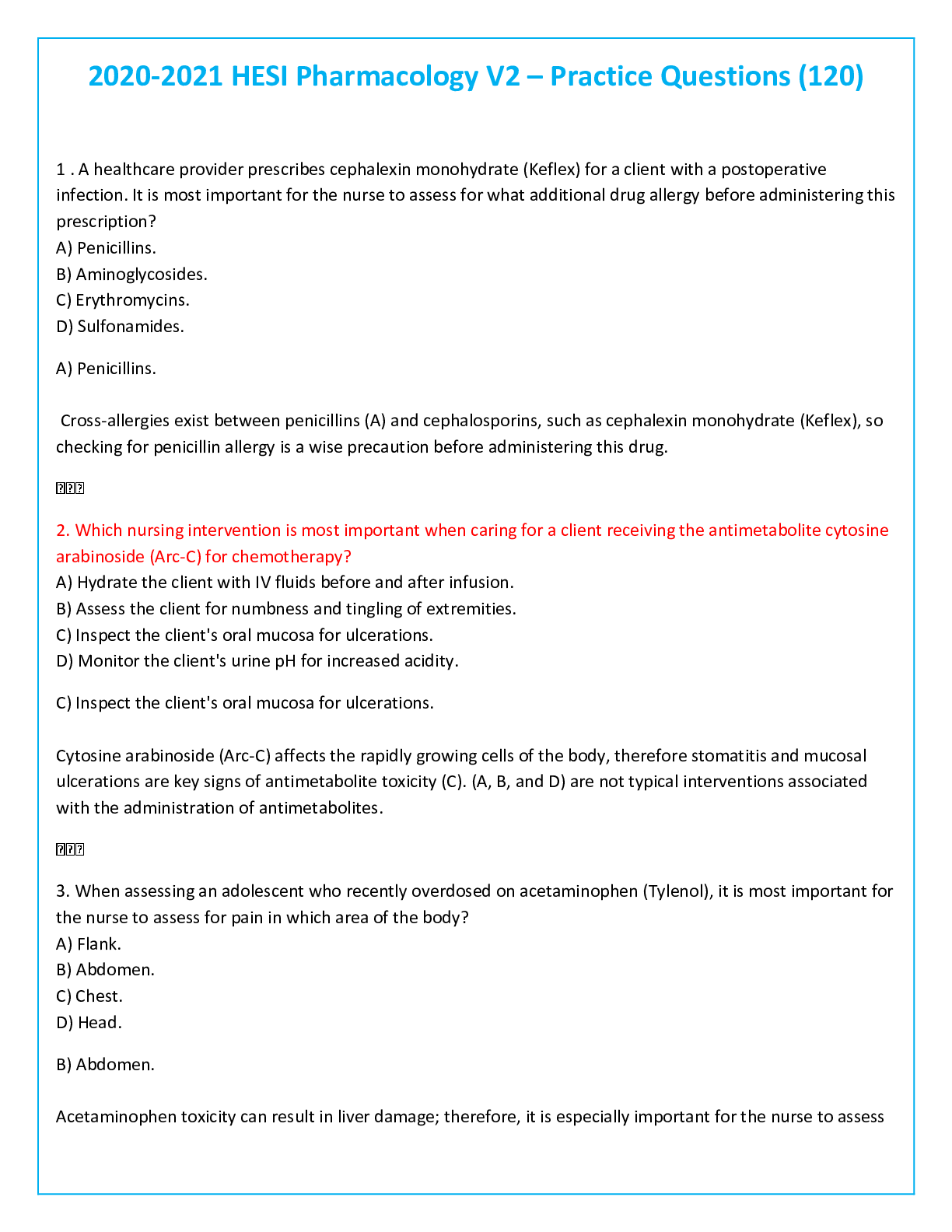*NURSING > HESI > HESI Radiography Practice Test 1a. Most Examined Questions and Answers. Graded A+ (All)
HESI Radiography Practice Test 1a. Most Examined Questions and Answers. Graded A+
Document Content and Description Below
Which procedure is an example of surgical asepsis? A. Clean glove application. B. Hand washing C. Clean gown application D. Surgical hand scrub. - D A radiographer receives a request for a po... rtable chest x-ray and then performs the x-ray on the incorrect patient. Which legal term best describes the actions of the radiographer? A. Battery B. Negligence C. Assault D. Invasion of privacy - A The lead radiographer is planning a strategy to efficiently manage the morning workload. The department is short-staffed due to meetings, and four patients are now ready for their examinations. Assuming that none of the exams is emergent, which patient should be seen first? A. An 54-year-old male with type 2 diabetes for an upper GI B. A 18-year-old female for an intravenous urogram C. An 83-year-old female for a chest x-ray D. A two-year-old child for a barium swallow - D Which type of contrast agent is preferred for low risk and low cost for a patient diagnosed with a possible perforated bowel? A. Barium sulfate suspension, flavored B. Gaseous media in the form of crystals C. Ionic, water soluble, diluted with juice D. Nonionic, water soluble, diluted with juice - C A patient reports symptoms including itching, rash formation, and difficulty breathing immediately following the administration of intravenous (IV) contrast media. Assuming the patient has had no prior exposure to radiopaque contrast media, what is the most likely cause of these symptoms? A. Acute bronchospasm B. Allergic reaction C. Anaphylactoid reaction D. Acute renal failure - C A patient received 100 ml of IV contrast media as a part of an abdominal computed tomography (CT) scan, as well as 500 ml of dilute, oral contrast, prior to coming to Radiology for a separate order, an intravenous urogram (IVU). The patient's creatinine is 0.4 mg/dl and BUN is 36 mg/dl. Why should this IVU be rescheduled? A. The presence of the previous oral contrast in the abdomen precludes an IVU. B. The lab values indicate increased risk for contrast injection. C. The lab values indicate that the contrast would not be excreted in sufficient quantity to be useful for an IVU. D. The presence of the previous intravenous contrast precludes an IVU - A The radiographer is assisting a patient to move from a wheelchair to the x-ray table. Which represents the safest practice by the radiographer when moving this patient? A. Maintain the center of gravity over the base of support. B. Extend the arms as far as possible to increase the base of support. C. Bend at the waist so the center of gravity is midway between the patient and the base of support. D. Reduce the base of support slightly so the center of gravity is easier to maintain. - A Which term best describes the process of cleaning the surfaces in a radiology department with 10% bleach solution in water? A. Sterile technique B. Medical asepsis C. Sterilization D. Surgical asepsis - B Which action is best taught to the patient using the communication technique of demonstration? A. The correct positioning for a particular projection. B. Instructions for donning and removing a patient gown. C. The correct direction to face when sitting at the radiography table. D. Direction on where to sit relative to the radiography table. - A Which actions should the radiographer take to help prevent acquired infections in hospitals or clinics? (Select the four that apply.) A. Placing used needles in sharps containers. B. Placing biologically soiled linen in biohazard linen bags. C. Wearing exam gloves and changing them between each patient. D. Placing used syringes in isolated trash receptacles. E. Washing hands frequently and using hand lotion afterward. - A. Placing used needles in sharps containers. B. Placing biologically soiled linen in biohazard linen bags. C. Wearing exam gloves and changing them between each patient. E. Washing hands frequently and using hand lotion afterward. Identify the medical conditions in a patient's history which should be cleared by the radiologist before injection of an ionic, water soluble, injectable contrast agent. (Select the four that apply.) A. Pheochromocytoma B. Age over 40 C. Compromised renal function D. Diabetes E. Sickle cell anemia - A. Pheochromocytoma C. Compromised renal function D. Diabetes E. Sickle cell anemia Which steps are involved in legally obtaining informed consent to perform a radiographic procedure? (Select the four that apply.) A. The patient has been informed about alternatives to this particular procedure. B. The patient has been informed about procedures in place to mitigate risks. C. The patient has been informed about the risks involved in the procedure. D. The patient is legally competent. E. The patient signed an informed consent form of their own volition in view of multiple witnesses - A. The patient has been informed about alternatives to this particular procedure. B. The patient has been informed about procedures in place to mitigate risks. C. The patient has been informed about the risks involved in the procedure. D. The patient is legally competent. How should a drug be administered to get the quickest response? A. Subcutaneously B. Intravenously C. Orally D. Rectally - B Which nonverbal cue best demonstrates attentiveness and concern for a patient who is giving a medical history? A. A pleasant smile. B. Consistent eye contact. C. Taking notes. D. Turning the head to the side to place one ear closer. - B A radiographer enters a room to take a portable foot series on a patient in her final trimester of pregnancy. The patient is just finishing her lunch and begins choking. How should the radiographer respond to this medical emergency? A. Place the patient in the Trendelenburg position. B. Start cardiopulmonary resuscitation (CPR). C. Apply an inward and upward thrust in the midline of the abdomen. D. Initiate a backward thrust in the center of the sternum. - D How should a radiographer increase the stability of the base of support? A. Hold heavy objects close to body. B. Stand with feet a greater distance apart. C. Stand on one foot. D. Keep back straight and knees bent. - B A radiographer prepares to transfer a patient from a wheelchair to the x-ray table. The patient recently suffered a stroke, exhibits left-sided weakness, and is able to bear some weight. How should the radiographer move the patient to the table? A. Use a hydraulic lift. B. Position the left side of the wheelchair next to the table. C. Position the right side of the wheelchair next to the table. D. Have one radiographer lift the torso while another lifts the feet. - C What does "ventricular fibrillation" mean? A. Premature ventricular contractions. B. Slow heart rate. C. Rapid heart rate. D. Erratically quivering ventricles - D A patient in the radiology department suddenly develops a nosebleed. The radiographer instructs the patient to lean forward and pinch the affected nostril against the midline nasal cartilage, but the bleeding does not stop. What should the radiographer do next? A. Instruct the patient to tilt the head back. B. Transport the patient to the emergency room. C. Apply a moist compress. D. Place the patient in a recumbent position. - C Which is the best approach for speaking to a patient with a hearing impairment? A. Ask patient to adjust hearing aid volume. B. Do not make eye contact. C. Speak in a low register. D. Talk very slowly. - C Which rule is followed when examining unconscious patients? A. Proceed as if the patient were conscious, asking questions and giving instructions. B. Remain as quiet as possible to avoid waking the patient during the exam. C. Speak openly in front of the patient, since they cannot hear or understand you. D. Avoid saying things you would not say to a conscious patient. - D What should the radiographer do if a radiologist's instructions are unclear? A. Ask for clarification B. Question the lead technologist C. Read the protocol book D. Perform the exam in the usual way - A What is the wide spread of Methicillin-resistant Staphylococcus aureas (MRSA) mainly attributed to? A. Improper cleaning of medical equipment. B. Poor hygiene and overuse of pain killers. C. Over prescription of antibiotics and poor infection control practices. D. Use of antibiotics with immunosuppressed patients. - C Which is the most appropriate guideline to follow when radiographing patients in their late adult years? A. Perform the exam as quickly as possible. B. Assume the patient has reduced mental capacity. C. Repeat instructions often so the patient won't forget. D. Speak slowly and in a low tone of voice. - D Which legal concept is violated by a radiographer who performs an examination without an examination order? A. Malpractice B. Battery C. Res ipsa loquitor D. Respondeat superior - B During preparation for a surgical procedure, an unopened sterile package becomes damp from an accidental spill of saline. Which response is most appropriate? A. Consider the package contaminated and replace it with a sterile item. B. Quickly remove the instrument from the package and add it to the sterile field. C. Dry the package with a sterile towel and continue preparations. D. Continue to use the damp package if sterility is not essential. - A Which angle of insertion is recommended when performing venipuncture? A. 5 degrees B. 15 degrees C. 45 degrees D. 90 degrees - B [Show More]
Last updated: 1 year ago
Preview 1 out of 49 pages
Instant download
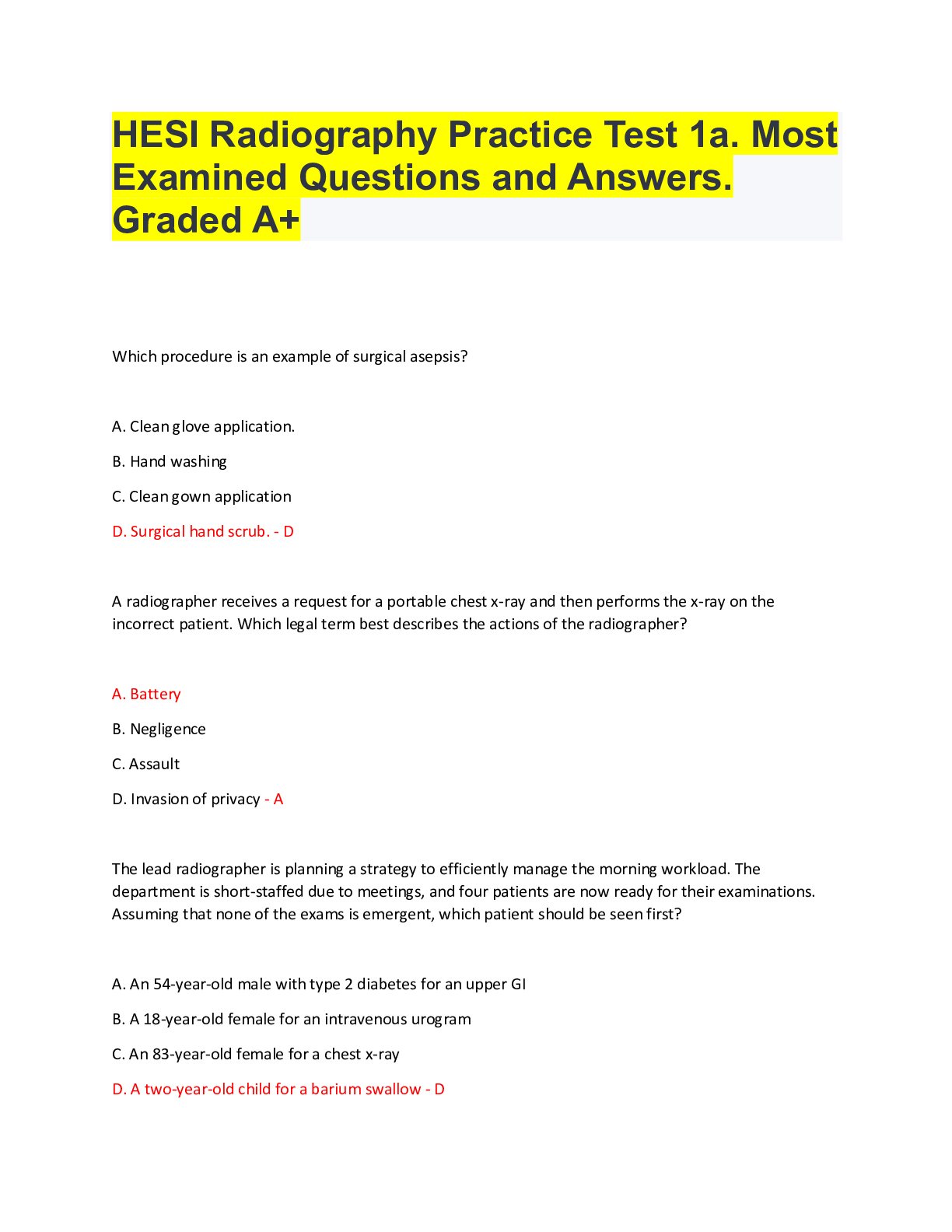
Instant download
Reviews( 0 )
Document information
Connected school, study & course
About the document
Uploaded On
Mar 28, 2022
Number of pages
49
Written in
Additional information
This document has been written for:
Uploaded
Mar 28, 2022
Downloads
0
Views
62

